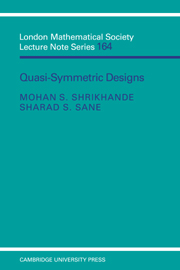Book contents
- Frontmatter
- Contents
- Preface
- Acknowledgments
- I Basic results from designs
- II Strongly regular graphs and partial geometries
- III Basic results on quasi-symmetric designs
- IV Some configurations related to strongly regular graphs and quasi-symmetric designs
- V Strongly regular graphs with strongly regular decompositions
- VI The Witt designs
- VII Extensions of symmetric designs
- VIII Quasi-symmetric 2-designs
- IX Towards a classification of quasi-symmetric 3-designs
- X Codes and quasi-symmetric designs
- References
- Index
VIII - Quasi-symmetric 2-designs
Published online by Cambridge University Press: 05 May 2010
- Frontmatter
- Contents
- Preface
- Acknowledgments
- I Basic results from designs
- II Strongly regular graphs and partial geometries
- III Basic results on quasi-symmetric designs
- IV Some configurations related to strongly regular graphs and quasi-symmetric designs
- V Strongly regular graphs with strongly regular decompositions
- VI The Witt designs
- VII Extensions of symmetric designs
- VIII Quasi-symmetric 2-designs
- IX Towards a classification of quasi-symmetric 3-designs
- X Codes and quasi-symmetric designs
- References
- Index
Summary
In our earlier chapters, we have looked at various classes of (sometimes only parametrically possible) quasi-symmetric designs. This chapter is devoted to the study of quasi-symmetric designs in general, particularly from a structural point of view. While Cameron's Theorem (Theorem 1.29) certainly boosted the interest in quasi-symmetric designs, it seems to be only in the last ten years or so that the structural investigations of quasi-symmetric designs began. The investigations are far from complete and we wish to give an account of the work in this area. The strong regularity of the block graph of a q.s. (= quasi-symmetric) design has been exploited in a paper of Neumaier. However, the design-structural properties of q.s. designs were probably first studied in a paper of Baartmans and M.S. Shrikhande. In that paper, q.s. designs with (x, y) = (0, y), y ≥ 2 and with no three mutually disjoint blocks were studied. Typical examples are Eλ and Qλ of Chapter VII (Convention 7.12). Various modifications and improvements of the results in that paper have been obtained and the results have been generalized in two different directions. The main part of this chapter is to give a summary of most of the results in these directions.
Throughout this chapter, D denotes a quasi-symmetric (q.s.) design with parameter set (v, b, r, k, λ) and with block intersection numbers x and y where x ≤ y.
- Type
- Chapter
- Information
- Quasi-symmetric Designs , pp. 141 - 173Publisher: Cambridge University PressPrint publication year: 1991



